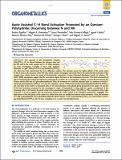Por favor, use este identificador para citar o enlazar a este item:
http://hdl.handle.net/10261/118255COMPARTIR / EXPORTAR:
 SHARE SHARE
 CORE
BASE CORE
BASE
|
|
| Visualizar otros formatos: MARC | Dublin Core | RDF | ORE | MODS | METS | DIDL | DATACITE | |

| Campo DC | Valor | Lengua/Idioma |
|---|---|---|
| dc.contributor.author | Eguillor, Beatriz | - |
| dc.contributor.author | Esteruelas, Miguel A. | - |
| dc.contributor.author | Fernández, Israel | - |
| dc.contributor.author | Gómez-Gallego, Mar | - |
| dc.contributor.author | Lledós, Agustí | - |
| dc.contributor.author | Martín-Ortíz, Mamen | - |
| dc.contributor.author | Oliván, Montserrat | - |
| dc.contributor.author | Oñate, Enrique | - |
| dc.contributor.author | Sierra, Miguel A. | - |
| dc.date.accessioned | 2015-07-27T08:54:20Z | - |
| dc.date.available | 2015-07-27T08:54:20Z | - |
| dc.date.issued | 2015 | - |
| dc.identifier | doi: 10.1021/acs.organomet.5b00174 | - |
| dc.identifier | issn: 0276-7333 | - |
| dc.identifier | e-issn: 1520-6041 | - |
| dc.identifier.citation | Organometallics 34(10): 1898-1910 (2015) | - |
| dc.identifier.uri | http://hdl.handle.net/10261/118255 | - |
| dc.description | This is an open access article published under a Creative Commons Attribution (CC-BY) License. | - |
| dc.description.abstract | The capacity of the hexahydride complex OsH6(PiPr3)2 (1) to discern between the nitrogen atom and the NH unit in the azole assisted aryl C−H bond activation has been investigated. Complex 1 reacts with 2-phenylimidazole to give OsH3{κ2-C,N-(C6H4-imidazole)}(PiPr3)2 (2), which has been characterized by X-ray diffraction analysis. The structure proves the higher affinity of the metal center for the N atom in the presence of the NH unit, which remains unchanged, and reveals that in the solid state the molecules of this complex form infinite chains by means of intermolecular asymmetric 3-center bifurcated dihydrogen bonds. In solution, 1HDOSY NMR experiments suggest that the association degree decreases as the temperature increases. The fused six-membered ring of benzimidazole weakens the NH bond, enhancing its reactivity. As a consequence, complex 1 cannot discern between the N atom and the NH unit of 2-phenylbenzimidazole. Thus, the treatment of 1 with this substrate leads to a mixture of OsH3{κ2-C,N-(C6H4-benzimidazole)}(PiPr3)2 (3) and the dinuclear species (PiPr3)2H3Os(C6H4-benzimidazolate)OsH(η2-H2)(PiPr3)2 (4). The latter is the result of a N-assisted ortho-C−H bond activation of the phenyl group promoted by 0.5 equiv of 1 and the N−H bond activation promoted by the remaining 0.5 equiv of hexahydride 1 along with the agostic coordination of the remaining ortho-C−H bond to the metal center of the unsaturated fragment OsH(η 2-H2)(PiPr3)2. The comparison of the redox properties of 3 and 4 suggests that the interaction between the metal centers in the dinuclear compound is negligible. The replacement of the NH group of the azoles by a sulfur atom does not modify the behavior of the substrates. Thus, the reactions of 1 with 2-phenylthiazole and 2-phenylbenzothiazole afford OsH3{κ 2-C,N-(C6H4-thiazole)}(PiPr3)2 (5) and OsH3{κ2-C,N-(C6H4-benzothiazole)}(PiPr3)2 (6). In turn, complexes 2, 3, 5, and 6 are phosphorescent. | - |
| dc.description.sponsorship | Financial support from the Spanish MINECO and FEDER (Projects CTQ2013-46459-C2-01-P to M.A.S., CTQ2014-52799-P to M.A.E., CTQ2013-44303-P to I.F., CTQ2014-54071-P to A.L., and CTQ2014-51912-REDC, the DGA (E35), and the European Social Fund (FSE) is acknowledged. | - |
| dc.publisher | American Chemical Society | - |
| dc.relation | info:eu-repo/grantAgreement/MINECO/Plan Estatal de Investigación Científica y Técnica y de Innovación 2013-2016/CTQ2013-46459-C2-01-P | - |
| dc.relation | info:eu-repo/grantAgreement/MINECO/Plan Estatal de Investigación Científica y Técnica y de Innovación 2013-2016/CTQ2014-52799-P | - |
| dc.relation | info:eu-repo/grantAgreement/MINECO/Plan Estatal de Investigación Científica y Técnica y de Innovación 2013-2016/CTQ2013-44303-P | - |
| dc.relation | info:eu-repo/grantAgreement/MINECO/Plan Estatal de Investigación Científica y Técnica y de Innovación 2013-2016/CTQ2014-54071-P | - |
| dc.relation | info:eu-repo/grantAgreement/MINECO/Plan Estatal de Investigación Científica y Técnica y de Innovación 2013-2016/CTQ2014-51912-REDC | - |
| dc.relation.isversionof | Publisher's version | - |
| dc.rights | openAccess | - |
| dc.title | Azole assisted C-H bond activation promoted by an osmium-polyhydride: Discerning between N and NH | - |
| dc.type | artículo | - |
| dc.identifier.doi | 10.1021/acs.organomet.5b00174 | - |
| dc.relation.publisherversion | http://dx.doi.org/10.1021/acs.organomet.5b00174 | - |
| dc.date.updated | 2015-07-27T08:54:21Z | - |
| dc.description.version | Peer Reviewed | - |
| dc.language.rfc3066 | eng | - |
| dc.rights.license | https://creativecommons.org/licenses/by/4.0/ | - |
| dc.contributor.funder | Ministerio de Economía y Competitividad (España) | - |
| dc.contributor.funder | European Commission | - |
| dc.contributor.funder | Diputación General de Aragón | - |
| dc.relation.csic | Sí | - |
| dc.identifier.funder | http://dx.doi.org/10.13039/501100003329 | es_ES |
| dc.identifier.funder | http://dx.doi.org/10.13039/501100000780 | es_ES |
| dc.type.coar | http://purl.org/coar/resource_type/c_6501 | es_ES |
| item.openairetype | artículo | - |
| item.grantfulltext | open | - |
| item.openairecristype | http://purl.org/coar/resource_type/c_18cf | - |
| item.fulltext | With Fulltext | - |
| item.cerifentitytype | Publications | - |
| Aparece en las colecciones: | (ISQCH) Artículos | |
Ficheros en este ítem:
| Fichero | Descripción | Tamaño | Formato | |
|---|---|---|---|---|
| AzoleAssisted.pdf | 3,28 MB | Adobe PDF |  Visualizar/Abrir |
CORE Recommender
SCOPUSTM
Citations
28
checked on 05-may-2024
WEB OF SCIENCETM
Citations
25
checked on 29-feb-2024
Page view(s)
316
checked on 07-may-2024
Download(s)
203
checked on 07-may-2024
Google ScholarTM
Check
Altmetric
Altmetric
Este item está licenciado bajo una Licencia Creative Commons

